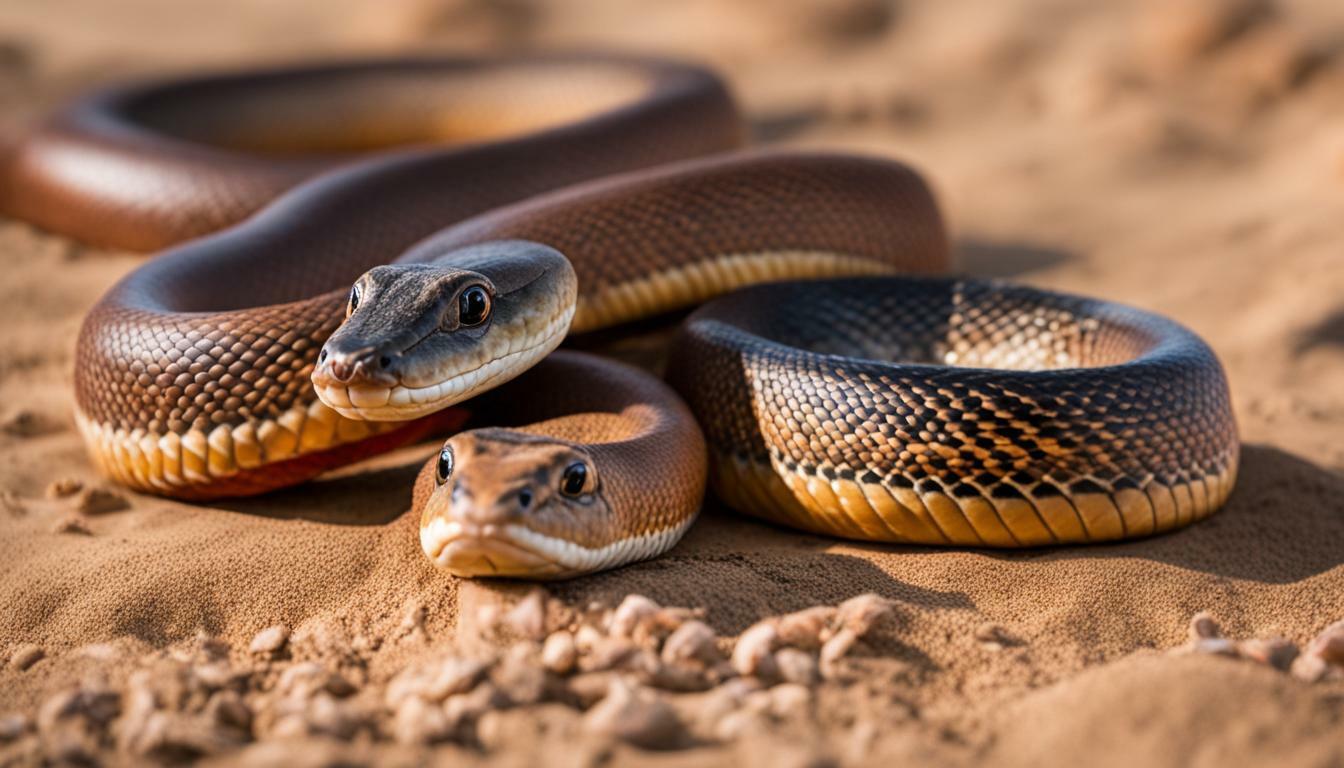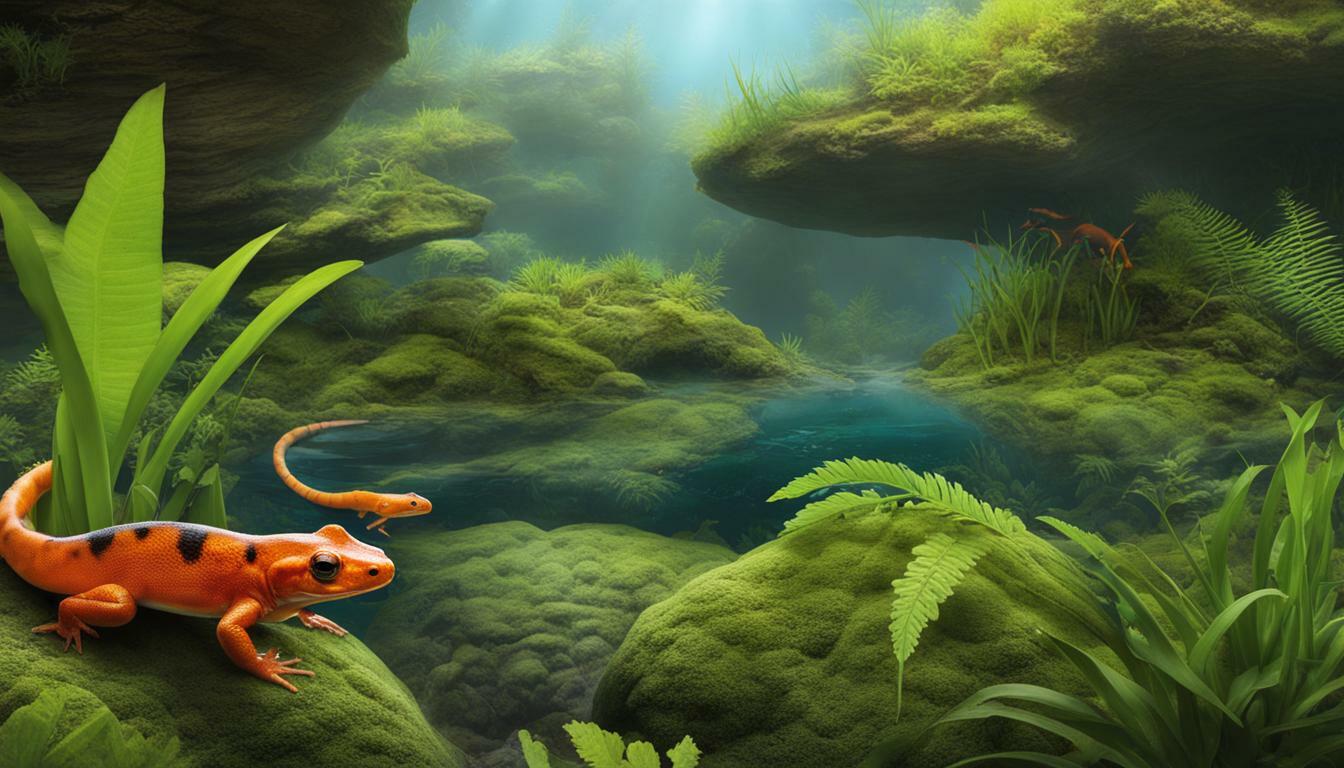Cottonmouths and water moccasins are venomous snakes found in the southeastern United States, but there are important distinctions between the two. They are scientifically known as Agkistrodon piscivorus and are commonly found in aquatic environments such as swamps, rivers, and wetlands.
Cottonmouths, also known as water moccasins, are large and heavy-bodied snakes with triangular heads and elliptical cat-eye pupils. They have brown bodies with olive and blackish markings, and their bellies have distinct stripes and markings that extend across. When feeling threatened, cottonmouths will coil and open their mouths wide in a defensive display, revealing their light white interiors that resemble cotton, hence the name “cottonmouth.”
On the other hand, water snakes are often mistaken for water moccasins. Unlike cottonmouths, water snakes are nonvenomous and pose no harm to humans. They have slender bodies, round pupils, and a much rounder head compared to the broad and triangular head of cottonmouths. When threatened, water snakes are more likely to flee rather than stand their ground like cottonmouths.
Key Takeaways:
- Cottonmouths and water moccasins are the same snake species, scientifically known as Agkistrodon piscivorus.
- Cottonmouths are venomous with a potentially deadly bite, while water snakes are nonvenomous and harmless to humans.
- Cottonmouths have triangular heads, elliptical cat-eye pupils, and brown bodies with olive and blackish markings.
- Water snakes have rounder heads, round pupils, and slender bodies.
- Cottonmouths are more likely to display defensive behaviors and stand their ground, while water snakes tend to flee when threatened.
Snake Identification: Cottonmouths and Water Moccasins
Cottonmouths and water moccasins can be distinguished by their appearance and unique features. These two snake species are often confused due to their similar habitats and overlapping geographical range. However, there are distinct characteristics that set them apart.
- Physical appearance: Cottonmouths are large, heavy-bodied snakes with a broad, triangular-shaped head. They have elliptical cat-eye pupils and dark-colored bodies with olive and blackish markings. On the other hand, water moccasins have slender bodies, round pupils, and a much rounder head compared to cottonmouths.
- Defensive behavior: When threatened, cottonmouths tend to stand their ground and display an aggressive defensive behavior. They will coil their bodies, open their mouths wide, revealing their white, cotton-like inner mouth. In contrast, water snakes are more likely to flee when faced with a potential threat.
It is important to note that cottonmouths, also known as water moccasins, are venomous snakes, while water snakes are nonvenomous and harmless to humans. If you encounter any snake, it is essential to keep a safe distance and avoid provoking or attempting to handle it.
To differentiate between cottonmouths and water moccasins, it is crucial to observe their physical characteristics, behavior, and habitat. Understanding these distinctions can help you make an informed decision in assessing the potential danger posed by these aquatic snakes.
For a detailed comparison, refer to the table below:
| Characteristics | Cottonmouths (Agkistrodon piscivorus) | Water Moccasins (Nerodia spp.) |
|---|---|---|
| Venomous? | Yes | No |
| Head Shape | Broad and triangular | Rounder |
| Pupils | Elliptical or cat-eye | Round |
| Defensive Display | Coiling, open mouth revealing white inner mouth | Tendency to flee |
| Body Coloration | Brown with olive and blackish markings | Varies by species |
| Venomous Bite | Potentially deadly | N/A |
Remember, regardless of whether a snake is venomous or not, it is always best to exercise caution and avoid unnecessary risk in snake encounters. Seek immediate medical attention if bitten by any snake.
Behavior and Traits of Cottonmouths
Cottonmouths exhibit distinct behaviors and possess traits that set them apart from other snakes. Understanding these behaviors and traits is crucial in identifying and avoiding potential encounters with these venomous reptiles.
One of the key characteristics of cottonmouths is their aggressive nature. When threatened or cornered, these snakes will coil their bodies and open their mouths wide, revealing the white lining that gives them their name. This defensive display serves as a warning to potential predators or intruders.
In addition to their defensive behavior, cottonmouths are known for their potent venom. Their bites can be potentially deadly, causing severe pain, tissue damage, and even death if left untreated. It is essential to exercise caution and keep a safe distance from these snakes if encountered.
Visually, cottonmouths can be distinguished by their physical appearance. They have large, heavy bodies with dark brown coloration and distinctive olive and blackish markings. Their elliptical cat-eye pupils and triangular-shaped heads further differentiate them from other nonvenomous water snakes.
| Traits of Cottonmouths | Description |
|---|---|
| Aggressive Behavior | When threatened, cottonmouths coil and open their mouths wide in a defensive display. |
| Venomous Bite | Cottonmouths possess potent venom, which can cause significant harm if bitten. |
| Distinctive Appearance | Cottonmouths have triangular heads, elliptical pupils, and brown bodies with olive and blackish markings. |
It is important to note that cottonmouths are often confused with nonvenomous water snakes. Water snakes have slender bodies, round pupils, and a rounder head compared to the broad and triangular head of cottonmouths. Unlike cottonmouths, water snakes are harmless to humans and tend to flee when threatened rather than engage in aggressive behavior.
Regardless of the type of snake encountered, it is crucial to maintain a safe distance and avoid any attempts to handle or provoke them. In the event of a snake bite, immediate medical attention should be sought, as even nonvenomous bites can result in infection or allergic reactions.
Water Moccasins: Nonvenomous Water Snakes
Unlike cottonmouths, water moccasins are nonvenomous and display different behavior patterns. These harmless water snakes are often mistaken for their venomous counterparts due to their similar appearance, especially in aquatic habitats such as swamps and rivers.
Water moccasins, also known as water snakes, have slender bodies and round pupils, distinguishing them from the heavy-bodied cottonmouths with elliptical cat-eye pupils. Their heads are much rounder in shape compared to the broad and triangular heads of cottonmouths. When confronted, water moccasins are more prone to fleeing rather than standing their ground, making them less aggressive overall.
It is essential to understand the distinction between these two snake species for personal safety and conservation efforts. Misidentifying a venomous cottonmouth can lead to unnecessary fear or harm to the snake itself. Remember that both cottonmouths and water moccasins are crucial parts of their ecosystems, contributing to the balance of aquatic environments. Should you encounter any snake, regardless of its venomous nature, it is advisable to maintain a safe distance and seek medical attention if bitten.
Physical Characteristics Comparison
| Species | Venomous? | Body Shape | Head Shape | Pupil Shape | Defensive Behavior |
|---|---|---|---|---|---|
| Cottonmouth | Yes | Large and heavy-bodied | Triangular | Elliptical (cat-eye) | Coil and open mouth display |
| Water Moccasin | No | Slender | Rounded | Round | Tendency to flee |
By understanding the physical characteristics and behavior of cottonmouths and water moccasins, we can better appreciate the diversity of snakes that inhabit our water ecosystems, ensuring their protection and our safety.
Conclusion
Differentiating between cottonmouths and water moccasins is crucial for those who come across venomous water snakes in aquatic environments. Cottonmouths, scientifically known as Agkistrodon piscivorus, are large, heavy-bodied snakes found in the southeastern United States. These snakes are venomous and possess a potentially deadly bite. They have triangular heads, elliptical cat-eye pupils, and a defensive display that includes coiling and opening their mouths wide. Cottonmouths’ brown bodies with olive and blackish markings, along with striped bellies, distinguish them.
On the other hand, water snakes are often mistaken for water moccasins. While water snakes share similar aquatic habitats, they are nonvenomous and pose no harm to humans. With slender bodies, round pupils, and rounder heads compared to cottonmouths, water snakes tend to flee when threatened. In contrast, cottonmouths are more likely to stand their ground.
It is essential to maintain a safe distance from any snake encountered and seek immediate medical attention in the event of a snake bite, irrespective of the snake’s venomous or nonvenomous status. Understanding the differences between cottonmouths and water moccasins can help individuals make informed decisions and exercise caution when encountering these venomous water snakes in aquatic environments.
FAQ
Are cottonmouths and water moccasins the same snake?
Yes, cottonmouths and water moccasins are the same snake, scientifically known as Agkistrodon piscivorus.
Where are cottonmouths found?
Cottonmouths are found in the southeastern United States in aquatic environments like swamps, rivers, and wetlands.
Are cottonmouths venomous?
Yes, cottonmouths are venomous and have a potentially deadly bite.
How can I differentiate cottonmouths from water snakes?
Cottonmouths have triangular heads, elliptical cat-eye pupils, and a defensive display where they coil and open their mouths. Water snakes have slender bodies, round pupils, and tend to flee when threatened.
What do cottonmouths look like?
Cottonmouths have brown bodies with olive and blackish markings. Their bellies have stripes and markings that extend across. The inside of their mouths is light white, resembling cotton.
Are water snakes dangerous to humans?
Unlike cottonmouths, water snakes are nonvenomous and harmless to humans.
What should I do if bitten by a snake?
It is important to seek medical attention immediately in the event of a snake bite, regardless of whether it is a venomous snake or not.
 Skip to main content
Skip to main content


